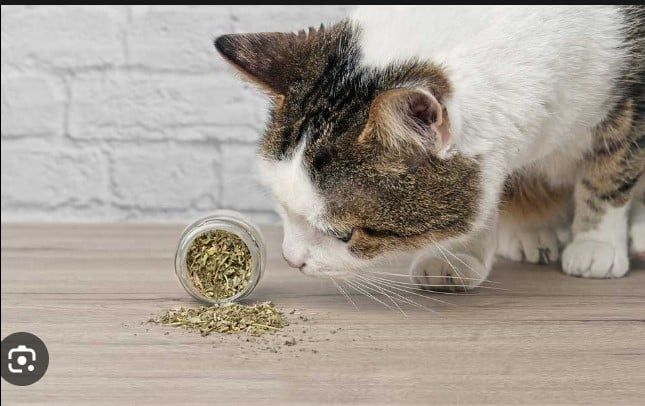Cats are puzzling animals, and the way they act can be confusing and entertaining for us humans. One of the mysteries about our cat buddies is the interesting reaction they have to catnip, a plant belonging to the mint family. In this post, we shall talk about, “What does Catnip do to Cats?”. We also discussed Understanding Catnip Plants and How does Catnip Work?. As well as the Effect of Catnip on Cats and The Catnip Sensation.
Lots of people know about catnip, but not everyone understands what kind of plant it is. Neither do they get the science behind how it influences a cat’s feelings and actions. This article will help you understand how catnip works, why cats love it so much, and whether it’s possible for a cat to have too much of it.
Understanding Catnip Plants
Catnip is a plant that belongs to the mint family. It has a chemical called nepetalactone in the glands on the underside of its leaves. When a cat chews or rubs on the leaves, it releases this oil.
You can find catnip in gardens or growing naturally where there’s enough sun and moisture. The plant has green, serrated leaves, and when you crush them, they give off a distinct smell. This smell comes from a compound called nepetalactone, which imitates the natural pheromones of cats. It’s interesting that not all cats react to it. In fact, about 50-75% of them have a genetic sensitivity to its charm.
See also: Is Lemongrass Safe for Cats?

How does Catnip Work?
Catnip has a special chemical called nepetalactone, which is a type of volatile oil found in the stem and leaves of the plant. When cats smell this chemical, it triggers certain brain chemicals that are linked to their mood and happiness. It’s worth noting that human brains are different from cat brains, so we don’t react to catnip in the same way.
The Catnip Sensation
Catnip doesn’t just affect a cat’s behavior right away. Many cat owners use catnip to make their cat’s environment more interesting. Toys infused with catnip are popular because they provide entertainment and mental stimulation for cats. Watching a cat play with a catnip toy is not only fun but also helps with their exercise, keeping them healthy.
Additionally, this can be used strategically to encourage good behaviors. For example, putting catnip on a scratching post can attract a cat to use it, helping to steer their natural instinct to scratch away from furniture and other surfaces you’d rather keep scratch-free.
See also: Can Cats Eat Cherries?

Effect of Catnip on Cats
Cats have a special scent organ called the vomeronasal gland in the roof of their mouth. This helps scents collected in the nose and mouth to reach the brain. Nepetalactone is an oil in catnip leaves that can change a cat’s behavior. To be affected, a cat needs to smell it
Catnip imitates cat sex hormones, so cats exposed to it may act like a female cat in heat, regardless of gender. This can include affection, relaxation, happiness, playfulness, or even aggression.
For cats that enjoy this plant, it can help reduce anxiety and relieve pain. Some vets suggest using catnip to ease separation anxiety when a cat is alone for a while.
How Long does Catnip last?
The impact of catnip on cats can differ, and the behaviors linked to smelling it typically last for about 10 minutes before slowly fading away. After that, it might take around 30 minutes without exposure to catnip for the cat to respond to it again.
Catnip tends to lose its strength over time, so it’s a good idea to store it in a sealed container to keep it fresh for as long as possible.
See also: Can Cats Eat Raspberries?

Is this plant Safe for Cats?
Catnip is usually safe for cats, and the effects, like rolling, rubbing, and increased activity, are normal behaviors. However, it’s important to use catnip in moderation because too much exposure can make cats less sensitive to it over time. Like with anything, if used too much, the excitement may wear off, and the cat might not respond as much.
When introducing catnip to your cat, watch their reaction and make sure they don’t eat a lot. Eating a large amount is uncommon, but it might cause mild stomach upset. Most cats prefer to interact with catnip by sniffing and playing with it rather than eating it.
Does it work on all Cats?
Not every cat reacts to the stuff in catnip. Vet studies show that around 60% of cats will show some behavior changes with catnip. If your cat doesn’t respond to the plant, you might want to give silver vine a shot.
It seems that how a cat reacts to this plant is mostly determined by their genes – like a family trait.
See also: Are Money Trees Toxic to Cats?

Can Cats Overdose?
Giving your cat too much catnip can lead to health issues like vomiting, diarrhea, dizziness, or difficulty walking. Use a small amount, and it’s a good idea to talk to your vet about the right dose for your cat.
Fresh catnip is stronger than the dried kind, so you don’t need to give your pet as much. It’s also wise to steer clear of highly concentrated catnip oils because they are very potent.
Temporary Effects
Catnip’s effects don’t last long, usually around 10 to 15 minutes. After that, the cat becomes temporarily immune to plant’s attraction. This period of being immune can last from 30 minutes to a couple of hours, during which the cat won’t react to it. But don’t worry, the cat usually becomes sensitive to it again after some time.
See also: Are Poinsettias Poisonous to Cats?

How to Use
Catnip comes in various types:
- Fresh catnip (growing your own catnip plant)
- Dried catnip
- Catnip sprays or bubbles
- Toys filled with dried catnip
If your cat tends to have a stomachache from eating the plant, using catnip sprays can be a good choice. You can spray it on your cat’s favorite toy, cat tree, or scratching post. Alternatively, you can sprinkle dried catnip on a cat tree, scratching post, or cardboard scratcher, or even roll a toy in it.
Is it safe for Kittens?
It’s interesting to note that studies show kittens and young cats might not react to catnip until they grow up. This could be because their scent analyzer, called the vomeronasal organ, is not fully developed. Some kittens might even dislike catnip until they become adults. Since kittens are already quite playful and can find ways to have fun on their own, there’s no rush to introduce catnip at such an early age.
See also: Can Cats Eat Mushrooms?

Should you Use Catnip for your Cat?
Many cat toys use catnip to make cats excited to play. Catnip can bring out lively moments in less active cats. However, just giving catnip isn’t enough for a cat’s daily fun. Cats need different ways to stay mentally and physically active each day, and their toys should match their play preferences. For example, a cat that loves chasing things with feathers might not care as much for a catnip-filled toy compared to a cat that thinks finding a comfy spot on the couch is a workout (relatable!).
If you decide to use catnip, make sure it’s good quality. When buying dried catnip, check the packaging and choose brands that mention they use only leaves and blossoms. Brands with lots of stems might not be as good.
Can my Cat hate Catnip?
Cats don’t all act the same way when they come across catnip. While many become calm and happy, some might get super energetic or even aggressive, feeling a sense of ‘euphoria.’ There are also cats that don’t react to catnip at all.
The reasons for these variations are both genetic and based on the cat’s personality. First, sensitivity to catnip is passed down through genes, so some might not have the genes that make them respond to it. Second, just like in humans, some cats naturally react differently to things.
These differences not only affect their emotional response, like being relaxed or hyperactive, but also influence how they interact with it– whether they eat it, roll around in it, or just give it a sniff.
See also: Is Bamboo Toxic to Cats?

Conclusion
In the mysterious world of cats, catnip is a fascinating and somewhat puzzling thing. The funny and interesting reactions cats have to catnip add an entertaining twist to our understanding of these mysterious creatures. While not every cat is into this, for those that are, it’s a joyful and brief break from their usual behavior.
Understanding the science behind how catnip affects cats helps us see how intricate their senses are. It also gives cat owners a useful tool to make their pets’ lives more fun through play and positive reinforcement. As we keep figuring out the secrets of cat behavior, this plant shows us the intriguing mix of nature, chemistry, and the captivating world of our dear feline friends.
See also: https://www.greatpetcare.com/wellness/silver-vine-for-cats/

